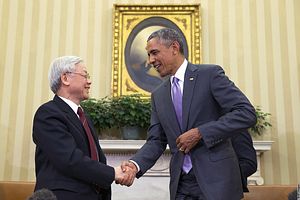Now that the U.S. arms embargo has been lifted, what might be on Hanoi’s shopping list? According to a recent article at Defense News, U.S. defense officials and industry reports suggest “a lot.”
Several months ago, I suggested that European producers would likely have the upper hand in any future sales to Vietnam. However, the documents obtained by Defense News suggest some optimism that the US might sell F-16 Viper fighters to the Vietnam People’s Air Force. The F-16 is an interesting choice for Hanoi, likely governed by price considerations (Vietnam is apparently looking for a deal similar to that of Indonesia, which received 24 Vipers for $750 million). The VPAF’s fighter inventory is now constituted entirely by relatively modern Flanker variants. While the single-engine F-16 isn’t ideal for maritime patrol, it nevertheless could provide a credible option for local air defense and for strike.
But while the F-16s might capture headlines, the far more interesting moves come in the area of maritime ISR. Vietnam appears interested in acquiring American drones, radars, surveillance equipment, and electronic warfare capabilities. Most interesting of all, Vietnam appears to want P-3 Orion maritime patrol aircraft, which would massively increase its surface and anti-submarine warfare capabilities. The VPAF and Vietnam People’s Navy (VPN) currently have exceedingly modest maritime patrol assets, making it very difficult for Vietnam to fully link its kill chain between “see-ers” and “shooters.”
These are exactly the kinds of capabilities that Vietnam can use to exert greater control over the South China Sea. Not coincidentally, this is precisely the geostrategic outcome the U.S. would like; an ally that can challenge the PLAN and the PLAAF in what they believe to be their own back yard. It’s worth noting, of course, that purchasing equipment from the United States would make it easier to integrate U.S. and Vietnamese capabilities during a conflict in the South China Sea. Any arms sale would necessarily require the deployment of U.S. trainers, advisors, and technicians, facilitating the development of a long-term U.S.-Vietnam military relationship.
There is no question that the elimination of the arms embargo will give the VPAF and the VPN far more effective eyes on developments in the South China Sea. Combined with existing Vietnamese cruise missile and SAM capabilities, these systems can provide the key link in the kill chain, and potentially a strong deterrent threat against Chinese military activities. And this is precisely the outcome that the Obama administration (and the U.S. defense industrial complex) wanted when it lifted the arms embargo on Vietnam.

































